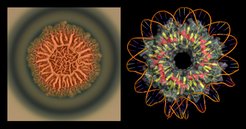Molecular Curlers
How the protein RemA mediates the formation of bacterial biofilms
Biofilms are tissue-like structures in which bacteria live together in close community. They are of medical relevance because biofilms protect the bacterial cells against the immune system's defenses or antibiotics.Now, a team led by Max Planck Fellow Gert Bange has been able to show how the protein RemA interacts with DNA and thus controls biofilm formation.

To control the formation of tissue-like structures - so-called biofilms - the protein RemA forms a ring that the DNA wraps around. A team from Marburg biology and chemistry describes this discovery in the scientific journal "Nature Communications".
Biofilms are communities of bacteria that live together in a tissue-like layer. Biofilms are of great medical importance; after all, the majority of known bacterial pathogens use biofilms to protect themselves from the body's immune defenses and antibiotics.
In the Firmicutes group of bacteria, the protein RemA activates the three major groups of genes that enable the bacteria to form biofilms. "The mechanistic details of how this molecule controls cell differentiation were unknown until now," explains biochemist Professor Dr. Gert Bange of Philipps University Marburg, who led the research.
In particular, scientists did not yet understand how RemA interacts with those segments of the genetic material DNA that influence the structure of the biofilm. The team elucidated the molecular structure of RemA to close this existing research gap. In the process, they discovered that eight copies of the protein join together to form a ring - the research group compares it to a donut.
The scientists analyzed RemA using molecular-genetic and structural-biochemical methods. For this purpose, the research groups of Bange and the Marburg biologist Professor Dr. Erhard Bremer joined forces with Professor Dr. Daniel Kearns from Indiana University in the USA.
The findings suggest that DNA can wrap around the RemA ring, much like hair wraps around a curler. "If the ring structure of RemA is disrupted, the complete formation of the biofilm will not function," says Erhard Bremer.
Biosciences are among the profile areas of Marburg's research. Professor Dr. Gert Bange teaches biochemistry at the Department of Chemistry at Philipps University in Marburg. He is part of the Marburg Center for Synthetic Microbiology (SYNMIKRO) and the Max Planck Institute for Terrestrial Microbiology in Marburg, and in 2021 he received an ERC Advanced Grant from the European Research Council. Professor Dr. Erhard Bremer teaches microbiology at Philipps University and is also a member of SYNMIKRO. The German Research Foundation funded the study through its Marburg Collaborative Research Center 987.












